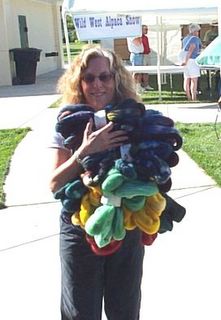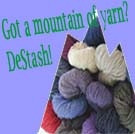Happy Earth Day!
Today has been designated as Earth Day for the past 35 years. Now, this being a primarily knitting blog, you may wonder what the big deal is, but I decided I would do my part this year by providing some information about how we all can be more Earth-friendly knitters. Some of you may be bailing already, thinking, "I don't WANT anybody telling me to reduce my consumption of yarn!", but hang in here with me for a bit.
The four R's of living in an Earth-friendly manner are "Reduce, Reuse, Restore, and Recycle", and I am going to tell you ways that knitters can do just that.
1. Reduce: I am not asking knitters to reduce their production of knitted goods, but to reduce their push for increased exploitation of resources. Those of you who only use natural fibers are probably glowing right now, thinking, "MY knitting supports family-friendly sheep farms". I hope that is true. Each knitter can and should explore where and how the yarns they are purchasing are made. One the big environmental problems with cotton, for example, is that traditional cotton agriculture employs HUGE amounts of pesticides (bad, bad, bad, in case you didn't know). The trend towards organic cotton has really picked up momentum in the past several years and there are now some great natural-color cotton yarns available. It is also possible to buy direct from many woolen mills, thereby reducing packaging and shipping costs.
Try to track down manufacturers that are close to you, support the handspinners in your area, and re-examine your habits around purchasing the latest goodies and gadgets or patterns and magazines. I know that I personally have about five lifetimes' worth of patterns stored up already, and still fall to the temptation of buying new ones. I have also turned to the Internet for pattern resources, and found some really great stuff, but have to consciously resist the urge to buy yet more yarn/needles/etc. in order to be part of the latest knitalong. I can also cut down on my paper consumption by saving those patterns to the computer hard drive and thinking awhile before printing them off and adding them to already-bulging files of other patterns I printed from the Internet because they were free, but haven't gotten around to making yet. We can all also cut down on our paper usage by taking a really cool felted or market bag to the store to haul those yarn purchases home!
And, for those that are interested, there is still an on-going debate about whether computer technology is more or less resource draining/environmentally friendly, but I will leave that to others to argue.
2. Reuse: Here is where I give out gold stars to those of you who went to the thrift stores and yard sales to pick up your collection of knitting needles, and checked the used book stores for fresh pattern inspiration. I have found some of my favorite knitting books in used book stores over the years. Ebay has also greatly increased the resale market for things like yarn, that someone else purchased but didn't ever get around to using. If you have yarn stashed away that you know you don't like or won't use, think about getting it back into the resource stream... someone else will love it, and they will be reusing a valuable resource. If you don't want to bother selling it on Ebay, take it to your guild or Stitch N' Bitch meeting, or look into donating it to charity knitters in your area.
I am also giving out silver stars today to those who rely on their interchangeable needle sets over and over rather than going out and buying "new, pretty" ones. Guilds who are sharing equipment such as yarn swifts and ball winders also get silver starts. Once our yarn is made up, it is a pretty permanent situation, but if you don't like something, don't be afraid to rip it out and reuse the yarn to make something you will use and love.
3. Restore: I have to admit that this area has given me some trouble as I thought and wrote my way through this post. How do we as knitters go about "restoring"? Well, the obvious one is to rip out and make something new. But, another, and perhaps much more valuable way is that knitting is helping to restore some of the holes in our culture. Whenever people work with their hands, and share hand-made items, they are consuming far less resources than gas-powered machines that could do the same thing, but without the heart that is involved. Knitting is also bringing diverse groups together to share the fun and the wisdom of the craft, and getting at least a segment of our population connecting with each other instead of continuing the isolation that often has plagued our modern, transient way of life. Knitters build community. Good on all of us!
4. Recycle: I hope that every one of us is implementing ways to recycle in all of the areas of our lives, including knitting. We can pass on our left-over yarns, but the power we really have as knitting consumers is to build the demand for yarns made from recycled fibers. Some of the most beautiful and intriguing yarn out on the market today is made from recycled sari silk, either alone or in combination with wool. It is also possible to buy cotton yarn made from industrial cotton pre-consumer waste. Check out Yarn Rescue, a small business built around reclaiming speciality fibers... I have found an increasing number of reclaimed yarns available on Ebay in recent months. If you want to try this yourself, there is a great tutorial on recycling yarn at Neauveau.
If we as knitters don't purchase and use these recycled fibers and other recycled goods, the market to buy materials to create new recycled goods will never grow. When you are about to make a needed purchase, start pondering whether there is a recycled product on the market that will meet the same need.
Now that my sermon is over, go out and celebrate the Earth by enjoying this beautiful, warm, spring day.
The four R's of living in an Earth-friendly manner are "Reduce, Reuse, Restore, and Recycle", and I am going to tell you ways that knitters can do just that.
1. Reduce: I am not asking knitters to reduce their production of knitted goods, but to reduce their push for increased exploitation of resources. Those of you who only use natural fibers are probably glowing right now, thinking, "MY knitting supports family-friendly sheep farms". I hope that is true. Each knitter can and should explore where and how the yarns they are purchasing are made. One the big environmental problems with cotton, for example, is that traditional cotton agriculture employs HUGE amounts of pesticides (bad, bad, bad, in case you didn't know). The trend towards organic cotton has really picked up momentum in the past several years and there are now some great natural-color cotton yarns available. It is also possible to buy direct from many woolen mills, thereby reducing packaging and shipping costs.
Try to track down manufacturers that are close to you, support the handspinners in your area, and re-examine your habits around purchasing the latest goodies and gadgets or patterns and magazines. I know that I personally have about five lifetimes' worth of patterns stored up already, and still fall to the temptation of buying new ones. I have also turned to the Internet for pattern resources, and found some really great stuff, but have to consciously resist the urge to buy yet more yarn/needles/etc. in order to be part of the latest knitalong. I can also cut down on my paper consumption by saving those patterns to the computer hard drive and thinking awhile before printing them off and adding them to already-bulging files of other patterns I printed from the Internet because they were free, but haven't gotten around to making yet. We can all also cut down on our paper usage by taking a really cool felted or market bag to the store to haul those yarn purchases home!
And, for those that are interested, there is still an on-going debate about whether computer technology is more or less resource draining/environmentally friendly, but I will leave that to others to argue.
2. Reuse: Here is where I give out gold stars to those of you who went to the thrift stores and yard sales to pick up your collection of knitting needles, and checked the used book stores for fresh pattern inspiration. I have found some of my favorite knitting books in used book stores over the years. Ebay has also greatly increased the resale market for things like yarn, that someone else purchased but didn't ever get around to using. If you have yarn stashed away that you know you don't like or won't use, think about getting it back into the resource stream... someone else will love it, and they will be reusing a valuable resource. If you don't want to bother selling it on Ebay, take it to your guild or Stitch N' Bitch meeting, or look into donating it to charity knitters in your area.
I am also giving out silver stars today to those who rely on their interchangeable needle sets over and over rather than going out and buying "new, pretty" ones. Guilds who are sharing equipment such as yarn swifts and ball winders also get silver starts. Once our yarn is made up, it is a pretty permanent situation, but if you don't like something, don't be afraid to rip it out and reuse the yarn to make something you will use and love.
3. Restore: I have to admit that this area has given me some trouble as I thought and wrote my way through this post. How do we as knitters go about "restoring"? Well, the obvious one is to rip out and make something new. But, another, and perhaps much more valuable way is that knitting is helping to restore some of the holes in our culture. Whenever people work with their hands, and share hand-made items, they are consuming far less resources than gas-powered machines that could do the same thing, but without the heart that is involved. Knitting is also bringing diverse groups together to share the fun and the wisdom of the craft, and getting at least a segment of our population connecting with each other instead of continuing the isolation that often has plagued our modern, transient way of life. Knitters build community. Good on all of us!
4. Recycle: I hope that every one of us is implementing ways to recycle in all of the areas of our lives, including knitting. We can pass on our left-over yarns, but the power we really have as knitting consumers is to build the demand for yarns made from recycled fibers. Some of the most beautiful and intriguing yarn out on the market today is made from recycled sari silk, either alone or in combination with wool. It is also possible to buy cotton yarn made from industrial cotton pre-consumer waste. Check out Yarn Rescue, a small business built around reclaiming speciality fibers... I have found an increasing number of reclaimed yarns available on Ebay in recent months. If you want to try this yourself, there is a great tutorial on recycling yarn at Neauveau.
If we as knitters don't purchase and use these recycled fibers and other recycled goods, the market to buy materials to create new recycled goods will never grow. When you are about to make a needed purchase, start pondering whether there is a recycled product on the market that will meet the same need.
Now that my sermon is over, go out and celebrate the Earth by enjoying this beautiful, warm, spring day.













0 Comments:
Post a Comment
<< Home